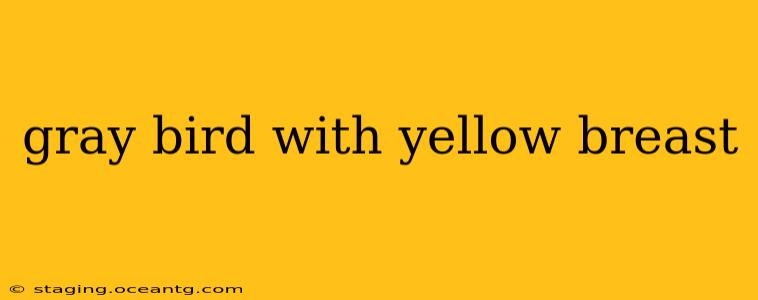Spotting a gray bird with a yellow breast can be exciting! Many species share this striking color combination, making identification a fun challenge. This guide will help you narrow down the possibilities, focusing on common species and offering tips for accurate identification. Understanding the nuances of their appearance, habitat, and calls will lead you to a positive ID.
What are some common gray birds with yellow breasts?
This depends heavily on your geographical location. The same bird won't be found everywhere. However, some common candidates in North America include:
-
Yellow-breasted Chat: This large, somewhat chunky bird is known for its distinctive, loud, and varied vocalizations. While mostly gray on top, its yellow breast is a key identifier. Its behavior is often described as skulking or elusive.
-
Eastern Meadowlark: Although predominantly brown on its back, this bird often shows a striking gray coloration on its wings and head. The vibrant yellow breast, punctuated by a distinctive black "V," makes it easily recognizable.
-
Western Meadowlark: Similar to its Eastern counterpart, but with a slightly different song and a richer, deeper yellow on the breast. Again, the gray is more apparent in its wings and head.
-
Yellow-rumped Warbler (Myrtle Warbler): While the yellow is more pronounced on its rump (the area above the tail), the breast often displays shades of yellow, particularly in males. The gray is on its back.
These are just a few examples; many other species may exhibit similar coloring but with subtle differences in shade, markings, or size.
What other colors might this bird have?
This is crucial for accurate identification. The presence of additional colors, even in small amounts, can significantly narrow the field. Consider:
- Head Color: Is the head gray, brown, black, or a mixture? Are there any noticeable stripes or markings?
- Wing Bars: Are there any contrasting bars or stripes across the wings? These are important identifying features.
- Tail Color: What color is the tail? Does it have any noticeable patterns?
- Bill Shape and Color: The shape and color of the bird's bill can also be very helpful.
Where did you see the gray bird with a yellow breast?
Habitat is a crucial element in identification. A bird seen in a meadow is less likely to be a certain forest species. Consider:
- Urban vs. Rural: Was it in a park, backyard, forest, field, or other environment?
- Type of Vegetation: Was it near trees, shrubs, tall grass, or open ground?
What size was the bird?
Relative size can help differentiate similar species. Was it larger than a robin, sparrow, or similar bird you're familiar with? Using a common bird for comparison is helpful in accurately assessing size.
What sound did the bird make?
Bird songs and calls are distinctive and extremely valuable for identification. Many apps are available to help you identify bird sounds by recording them and comparing them to a database.
How can I get a better look at the bird to identify it?
Patience and observation are key. Using binoculars will allow for a closer and more detailed look, revealing subtle characteristics often missed with the naked eye. Take your time, and you are more likely to observe the bird's behavior and other features needed to correctly identify it.
By carefully considering these factors, you can greatly improve your chances of accurately identifying that gray bird with a yellow breast. Remember, bird identification often requires combining several observations, so pay close attention to detail! Happy birding!
